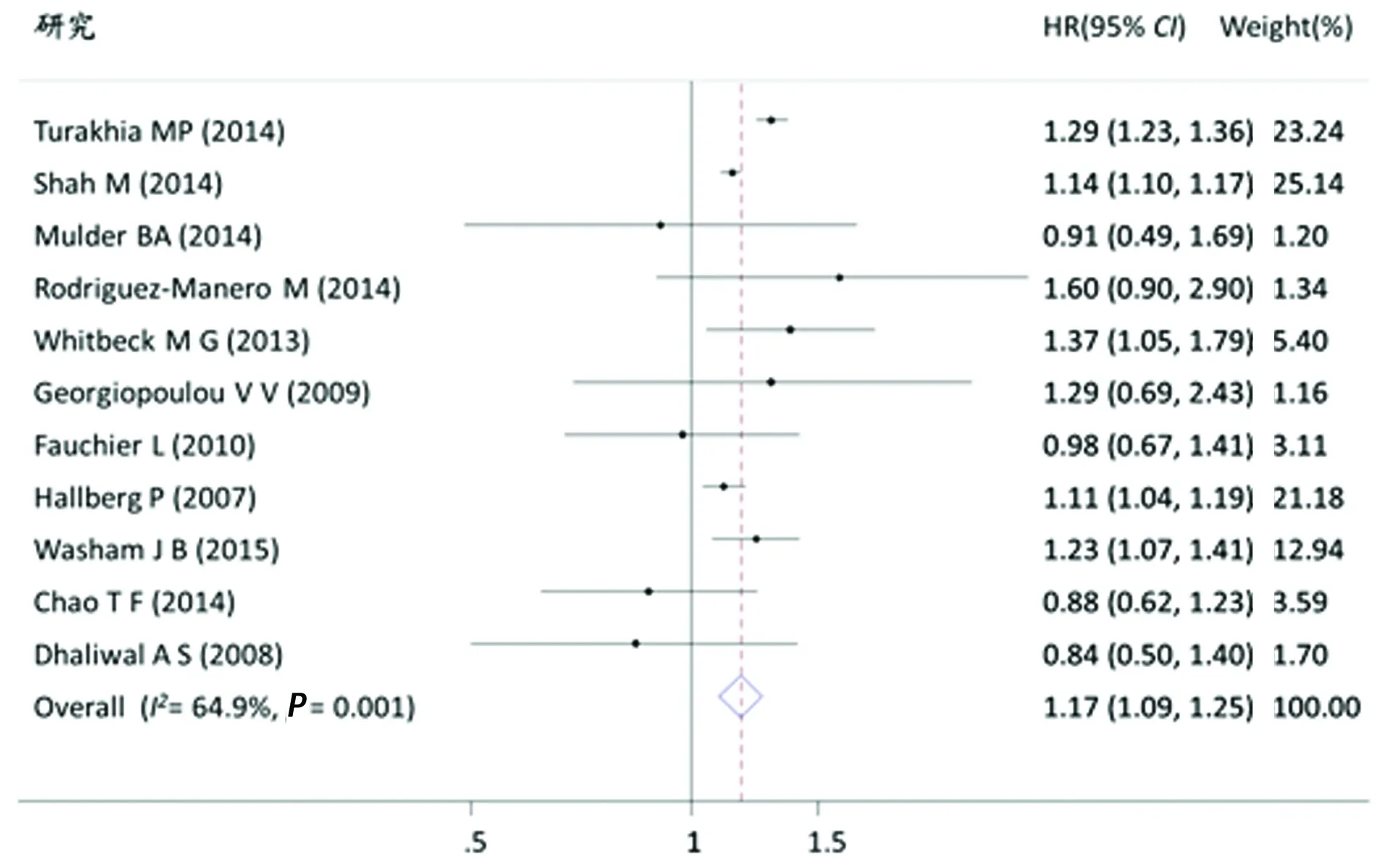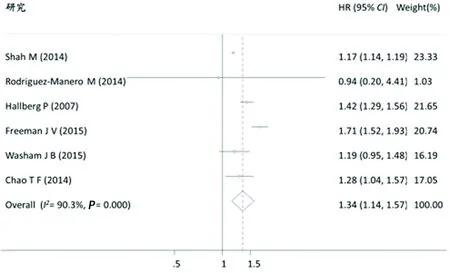地高辛用于心房颤动患者相关死亡风险的Meta分析*
邢方凯,丁红涛,赵宏兵
(1.解放军第71571部队卫生队,山东烟台 265500;2.解放军第456医院心内科,济南 250000)
·循证医学·
地高辛用于心房颤动患者相关死亡风险的Meta分析*
邢方凯1,丁红涛1,赵宏兵2△
(1.解放军第71571部队卫生队,山东烟台 265500;2.解放军第456医院心内科,济南 250000)
目的 探究服用地高辛与心房颤动患者死亡风险的关系。方法 检索PubMed、EMbase文献数据库中地高辛用于心房颤动治疗的相关性研究,应用STATA12.0进行敏感性分析及发表偏倚分析,并进行综述。结果 共纳入文献15篇、323 096例心房颤动患者,Meta分析显示地高辛的应用将使心房颤动患者增加20%的总体死亡风险[HR(95%CI)= 1.20(1.14,1.27),P<0.05],敏感性分析显示结果稳健;其中使合并心力衰竭患者的死亡风险增加17%[HR(95%CI)= 1.17(1.09,1.25),P<0.05],不伴心力衰竭患者增加34%[HR(95%CI)=1.34(1.14,1.57),P<0.05]。结论 无论是否伴有心力衰竭,服用地高辛均可能增加心房颤动患者的死亡风险。
地高辛;病死率;心房颤动;心力衰竭;Meta分析
心房颤动是临床最常见的房性心律失常,其在总体人群中的患病率为0.4~1.0%[1],其发病率也在逐年升高[2];心室率紊乱、心功能受损和心房附壁血栓形成是心房颤动患者的主要病理生理学特点。作为一种钠/钾-腺嘌呤核苷三磷酸酶(Na+/K+-ATPase)抑制剂,洋地黄类药物用于治疗心房颤动已经有很长的历史,至今地高辛仍被作为控制心房颤动患者心室率的常用药物广泛使用[3]。然而,地高辛的应用对心房颤动患者预后的影响一直存在争议,特别是近年来多项研究显示,地高辛可能增加心房颤动患者的病死率[4-5]。单一病例研究存在许多不可控的偏倚,本文检索已发表的地高辛用于心房颤动治疗的相关研究,根据流行病学观察性研究的Meta分析规范报告(MOOSE声明)[6],做一Meta分析,进一步探究服用地高辛对心房颤动患者病死率的影响。
1 资料与方法
1.1 资料检索 检索PubMed、EMBASE及The Cochrane Library等数据库。检索采用关键词与自由词相结合的方式,即:(“Digitalis” 或 “digoxin”)和 “atrial fibrillation” 和 (“mortality” 或 “death”),并对纳入文献的参考文献再次检索。
1.2 纳入和排除标准 纳入标准:(1)公开发表的前瞻性或回顾性队列研究,发表日期截止于2015年4月28日;(2)研究必须包含心房颤动患者服用地高辛或对照的总体病死率;(3)研究对象随访时间大于或等于6个月;(4)明确描述研究的可信区间及标准误或可以通过计算获得;(5)必须描述研究存在的混杂因素。排除标准:(1)非临床研究;(2)病例对照、综述性或个案报道文献;(3)重复发表的文献;(4)同时接受其他治疗方案的研究;(5)涉及相同研究时,排除较早发表的文献。
1.3 资料提取 研究检索、资料提取、质量评价由两人独立完成,若存在争议则通过讨论或邀请另一名仲裁者达成一致。质量评价采用Newcastle-Ottawa量表进行评估。资料提取的内容包括主要作者、发表年份、国家或地区、治疗方案和结局指标等。
1.4 统计学处理 采用STATA 12.0软件,各效应量以95%CI表示。采用I2检验判断研究间异质性,P>0.1,I2<50%为同质性好,I2>50%认为差异有统计学意义。研究间存在统计学同质性时,采用固定效应模型进行合并;若存在统计学异质性,进行敏感性分析和发表偏倚分析,应用随机效应模型合并。
2 结 果
2.1 文献检索结果 共检索到文献630 964篇,阅读题目及摘要,排除会议报告、综述、个案报告、指南、无原始数据、与研究无关、数据重复的文献,共有15篇文献纳入研究,见表1。
2.2 全因病死率 15项研究涉及地高辛用于心房颤动患者的全因病死率,共纳入服用地高辛的心房颤动患者84 032例(其中死亡病例31 174例),对照组239 064例(其中死亡病例74 113例),Meta分析显示纳入研究间存在统计学异质性(I2=75.1%),采用随机效应模型进行合并分析,地高辛用于心房颤动患者将使死亡风险增加20%[HR(95%CI)=1.20(1.14,1.27),P<0.05]。

表1 纳入研究的一般特征
2.3 地高辛用于心房颤动伴心力衰竭患者的死亡风险 11项研究涉及地高辛用于心房颤动合并心力衰竭患者的死亡风险,纳入研究间存在统计学异质性(I2=64.9%),采用随机效应模型进行合并分析,Meta分析显示服用地高辛可使心房颤动合并心力衰竭患者的死亡风险增加17%[HR(95%CI)= 1.17(1.09,1.25),P<0.05]。

图1 地高辛用于心房颤动患者的全因死亡风险

图2 地高辛用于心房颤动伴有心力衰竭 患者的全因病死率HR
2.4 地高辛用于心房颤动不伴有心力衰竭患者的死亡风险 6项研究涉及地高辛用于心房颤动患者的病死率,纳入研究间存在统计学异质性(I2=90.3%),采用随机效应模型进行合并分析,Meta分析显示服用地高辛可使心房颤动不伴心力衰竭患者的死亡风险增加34% [HR(95%CI)=1.34(1.14,1.57),P<0.05]。

图3 地高辛用于心房颤动不伴有心力 衰竭患者的死亡风险

图4 地高辛用于心房颤动患者的全因病死率敏感性分析
2.5 敏感性分析与发表偏倚 敏感性分析显示(图4),前瞻性研究对异质性的贡献较大,将纳入的研究按照前瞻性研究和回顾性研究进行亚组分析,两个亚组内的统计学异质性显著下降(I2=52.0%、43.4%)。对亚组再次进行Meta分析,结果仍显示服用地高辛显著增加用于心房颤动患者的死亡风险,提示模型可靠,分析结果稳健。对纳入研究进行发表偏倚分析,结果显示(图5),Begg′s检验P=0.692,Egger′s检验P=0.470,文献间不存在明显发表偏倚,分析结果稳健。

图5 地高辛用于心房颤动患者的全因病死率Begg漏斗图
3 讨 论
地高辛在心房颤动治疗中的历史有两百年之久,尽管诸如β受体阻滞剂、胺碘酮等药物越来越多地被广泛使用,低廉的价格使地高辛在现有治疗中仍占有一席之地。控制心率是地高辛治疗心房颤动的主要作用,其作用途径主要为通过抑制迷走神经传入神经纤维的Na+/K+-ATP酶,增强迷走神经张力,降低窦房结的自律性,减慢房室结传导速度,延长有效不应期,从而减慢心房颤动时的心率;此外,小剂量时可以提高窦房结对迷走神经冲动的敏感性而增强减慢心率的作用。正是由于地高辛作用于迷走神经来减慢心率,其控制安静状态下心率较好;但在机体运动时,房室结主要接受交感神经的控制,因此对心率的控制不佳,无法提升运动耐量。
上文Meta分析显示,无论是否伴有心力衰竭,服用地高辛均可能增加心房颤动患者的死亡风险。地高辛的药代动力学复杂,治疗窗口狭窄可能是增加死亡风险的重要原因。地高辛在体内转化代谢很少,主要以原形由肾脏排出,尿中排出量约占用量的50%~70%;心房颤动患者一般采用多药联合治疗,但与其他常用药物相互作用依然存在(胺碘酮、普罗帕酮、维拉帕米等均可提高其血药浓度)。最常见的不良反应是剂量相关的室性心律失常、房室传导阻滞以及窦性停搏。另外,地高辛的治疗窗较窄,研究显示,与安慰剂相比,地高辛血药浓度大于或等于1.2 ng/mL时可增加11.8%的死亡风险[20];其中,当血药浓度大于或等于1.7 ng/mL时,心律失常的发生风险将增加10%,而血药浓度大于或等于2.5 ng/mL时,发生风险将增加50%以上[21]。因此倘若不对血药浓度及血钾进行动态监测,容易发生药物中毒的风险。
总之,对于心房颤动患者使用地高辛,尤其对于老年及肾功能不良患者,应该谨慎使用。最近更新的AAC/AHA心房颤动指南[1]也指出,在心率控制时,Ⅰ类推荐药物为β受体阻滞剂和非二氢吡啶类钙通道阻滞剂,地高辛无推荐意见。尽管在观察性研究的基础上建议心房颤动心室率控制完全抛弃地高辛还为时过早,但其地位无疑会继续下降,其对心房颤动患者病死率的影响还有待进一步明确。
[1]January CT,Wann LS,Alpert JS,et al.2014 AHA/ACC/HRS guideline for the management of patients with atrial fibrillation:executive summary:a report of the American college of cardiology/American heart association task force on practice guidelines and the heart rhythm society[J].Circulation,2014,130(23):2071-2104.
[2]Schnabel RB,Yin X,Gona P,et al.50 year trends in atrial fibrillation prevalence,incidence,risk factors,and mortality in the Framingham Heart Study:a cohort study[J].Lancet,2015,386(9989):154-162.
[3]Fang MC,Stafford RS,Ruskin JN,et al.National trends in antiarrhythmic and antithrombotic medication use in atrial fibrillation[J].Arch Intern Med,2004,164(1):55-60.
[4]Turakhia MP,Santangeli P,Winkelmayer WC,et al.Increased mortality associated with digoxin in contemporary patients with atrial fibrillation:findings from the TREAT-AF study[J].J Am Coll Cardiol,2014,64(7):660-668.
[5]Whitbeck MG,Charnigo RJ,Khairy P,et al.Increased mortality among patients taking digoxin--analysis from the AFFIRM study[J].Eur Heart J,2013,34(20):1481-1488.
[6]Stroup DF,Berlin JA,Morton SC,et al.Meta-analysis of observational studies in epidemiology:a proposal for reporting.Meta-analysis Of Observational Studies in Epidemiology (MOOSE) group[J].JAMA,2000,283(15):2008-2012.
[7]Shah M,Avgil Tsadok M,Jackevicius CA,et al.Relation of digoxin use in atrial fibrillation and the risk of all-cause mortality in patients ≥65 years of age with versus without heart failure[J].Am J Cardiol,2014,114(3):401-406.
[8]Mulder BA,Van Veldhuisen DJ,Crijns HJ,et al.Digoxin in patients with permanent atrial fibrillation:data from the RACE Ⅱ study[J].Heart Rhythm,2014,11(9):1543-1550.
[10]Gheorghiade M,Fonarow GC,Van Veldhuisen DJ,et al.Lack of evidence of increased mortality among patients with atrial fibrillation taking digoxin:findings from post hoc propensity-matched analysis of the AFFIRM trial[J].Eur Heart J,2013,34(20):1489-1497.
[11]Friberg L,Hammar N,Rosenqvist M.Digoxin in atrial fibrillation:report from the Stockholm Cohort study of Atrial Fibrillation (SCAF)[J].Heart,2010,96(4):275-280.
[12]Georgiopoulou VV,Kalogeropoulos AP,Giamouzis G,et al.Digoxin therapy does not improve outcomes in patients with advanced heart failure on contemporary medical therapy[J].Circ Heart Fail,2009,2(2):90-97.
[13]Fauchier L,Grimard C,Pierre B,et al.Comparison of beta blocker and digoxin alone and in combination for management of patients with atrial fibrillation and heart failure[J].Am J Cardiol,2009,103(2):248-254.
[14]HallbergP,LindbäckJ,LindahlB,etal.Digoxin and mortality in atrial fibrillation:a prospective cohort study[J].Eur J Clin Pharmacol,2007,63(10):959-971.
[15]Gjesdal K,Feyzi J,Olsson SB.Digitalis:a dangerous drug in atrial fibrillation? An analysis of the SPORTIF Ⅲ and Ⅴ data[J].Heart,2008,94(2):191-196.
[16]Okin PM,Hille DA,Wachtell K,et al.Digoxin use and risk of mortality in hypertensive patients with atrial fibrillation[J].J Hypertens,2015,33(7):1480-1486.
[17]Washam JB,Stevens SR,Lokhnygina Y,et al.Digoxin use in patients with atrial fibrillation and adverse cardiovascular outcomes:a retrospective analysis of the Rivaroxaban Once Daily Oral Direct Factor Xa Inhibition Compared with Vitamin K Antagonism for Prevention of Stroke and Embolism Trial in[J].Lancet,2015,385(9985):2363-2370.
[18]Chao TF,Liu CJ,Chen SJ,et al.Does digoxin increase the risk of ischemic stroke and mortality in atrial fibrillation? A nationwide population-based cohort study[J].Can J Cardiol,2014,30(10):1190-1195.
[19]Dhaliwal AS,Bredikis A,Habib G,et al.Digoxin and clinical outcomes in systolic heart failure patients on contemporary background heart failure therapy[J].Am J Cardiol,2008,102(10):1356-1360.
[20]Rathore SS,Curtis JP,Wang Y,et al.Association of serum digoxin concentration and outcomes in patients with heart failure[J].JAMA,2003,289(7):871-878.
[21]Hardman JG,Limbird LE.Gilman AGGoodman and Gilman′s the pharmacological basis of therapeutics[M].10th ed.New York:McGraw-Hill,2001:1917-2023.
Death risk of digoxin use in patients with atrial fibrillation:a Meta analysis
XingFangkai1,DingHongtao1,ZhaoHongbing2△
(1.MedicalTeam,Unit71571ofPLA,Yantai,Shandong265500,China;2.DepartmentofCardiology,456HospitalofPLA,Jinan,Shandong250000,China)
Objective To investigate the association between digoxin administration with the death risk in the patients with atrial fibrillation (AF).Methods The related studies on digoxin for treating AF were retrieved from the literature databases of PubMed and EMbase.The sensitivity analysis and publication bias analysis were performed by using the STATA 12.0 software and the review was performed.Results Fifteen literatures were included,involving 323 096 patients with AF.The meta analysis showed that digoxin use increased the total death risk by 20% in the patients with AF [HR(95%CI)= 1.20(1.14 to 1.27),P<0.05].The sensitivity analysis showed that the results were steady,in which the death risk of complicating heart failure was increased by 17%[HR(95%CI)= 1.17(1.09,1.25),P<0.05)] and the death risk of non-complicating heart failure was increased by 34%[HR(95%CI)=1.34(1.14,1.57),P<0.05].Conclusion No matter whether complicating heart failure,taking digoxin increases the death risk in the in patients with AF.
digoxin;mortality;atrial fibrillation;heart failure;Meta analysis
邢方凯(1989-),医师,本科,主要从事心血管疾病及流行病学的研究。△
10.3969/j.issn.1671-8348.2016.32.020
R541.7
A
1671-8348(2016)32-4524-03
2016-04-18
2016-08-06)

